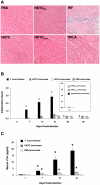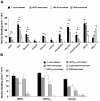Heat-killed Trypanosoma cruzi induces acute cardiac damage and polyantigenic autoimmunity
- PMID: 21283741
- PMCID: PMC3024973
- DOI: 10.1371/journal.pone.0014571
Heat-killed Trypanosoma cruzi induces acute cardiac damage and polyantigenic autoimmunity
Erratum in
- PLoS One. 2011;6(2). doi:10.1371/annotation/118b702e-9609-4f91-afba-6a76f8f1f14a
Abstract
Chagas heart disease, caused by the protozoan parasite Trypanosoma cruzi, is a potentially fatal cardiomyopathy often associated with cardiac autoimmunity. T. cruzi infection induces the development of autoimmunity to a number of antigens via molecular mimicry and other mechanisms, but the genesis and pathogenic potential of this autoimmune response has not been fully elucidated. To determine whether exposure to T. cruzi antigens alone in the absence of active infection is sufficient to induce autoimmunity, we immunized A/J mice with heat-killed T. cruzi (HKTC) emulsified in complete Freund's adjuvant, and compared the resulting immune response to that induced by infection with live T. cruzi. We found that HKTC immunization is capable of inducing acute cardiac damage, as evidenced by elevated serum cardiac troponin I, and that this damage is associated with the generation of polyantigenic humoral and cell-mediated autoimmunity with similar antigen specificity to that induced by infection with T. cruzi. However, while significant and preferential production of Th1 and Th17-associated cytokines, accompanied by myocarditis, develops in T. cruzi-infected mice, HKTC-immunized mice produce lower levels of these cytokines, do not develop Th1-skewed immunity, and lack tissue inflammation. These results demonstrate that exposure to parasite antigen alone is sufficient to induce autoimmunity and cardiac damage, yet additional immune factors, including a dominant Th1/Th17 immune response, are likely required to induce cardiac inflammation.
Conflict of interest statement
Figures






References
-
- Giordanengo L, Fretes R, Diaz H, Cano R, Bacile A, et al. Cruzipain induces autoimmune response against skeletal muscle and tissue damage in mice. Muscle Nerve. 2000;23:1407–1413. - PubMed
Publication types
MeSH terms
Substances
Grants and funding
LinkOut - more resources
Full Text Sources
Medical
Research Materials

